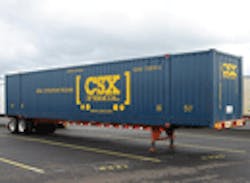Though suffering from the same broad fallout in freight volumes due to the global recession, intermodal service is gaining some U.S. transportation market share, according to analysts and service providers.
Lawrence Gross, senior consultant with research firm FTR Associates, has reported that intermodal gained market share against trucks in the fourth quarter last year, with its share of U.S. long-haul (550-plus mile) movements of international and domestic containerized freight estimated to reach 13.3%, up 0.2% from the third quarter of 2009.
“Intermodal has gained share for three consecutive quarters since the freight meltdown late last year,” Gross noted in his Intermodal Monthly Update. “This latest increase has been driven by improvement in the international intermodal sector, an indication that imports and exports are rebounding faster than domestic traffic. The market share of the domestic intermodal sector, which had been growing earlier in the year, [remained] flat in the fourth quarter.”
Gross said he expects this overall positive trend to continue. “Provided that the railroads maintain their current high levels of service, we see a variety of factors leading to a resumption of domestic share growth even as the international sector continues to rebound,” he added.
“I think there is still plenty of opportunity in the long haul [intermodal] sector,” noted Jack Koraleski, Union Pacific’s executive vp-marketing & sales, in the railroad’s fourth quarter earnings call with reporters.
“In terms of long haul west opportunities, when you look at the highway businesses moving out there today, there are still plenty of opportunities to convert business” to intermodal, he explained. “The growth prospects and the conversion from the highway business are quite strong. So, I don’t view it as just an eastern opportunity; I think we still have plenty of room” to grow intermodal share.
Though all of Union Pacific’s freight revenues declined in the fourth quarter last year, intermodal had one of the lowest drops. Automotive revenues dropped the least (1%), followed by intermodal (down 3%), agricultural (off 7%), chemicals (down 7%), energy (off 22%) and industrial products (down 28%).
CSX noted that its intermodal and automotive volumes grew in the fourth quarter last year, though overall freight levels declined 7% as that growth was offset by sharp declines in coal and merchandise rail traffic.
Kirk Thompson, president & CEO of truckload carrier J.B. Hunt Transportation Services, said in the company’s year-end earnings release that shippers are looking for more “integrated” freight services; and intermodal is playing a larger role in such strategies.
“While we are disappointed in the decline in [our] earnings, we are encouraged by the expanding connection we see between our business units and how we can leverage our services together for the benefit of our customers,” he said. “A growing number of shippers are using all of our services as a way to meet all of their supply chain needs; from using … our intermodal service, to final mile delivery of their products to the end consumer, our customers are embracing our integrated services.”
In 2009, Thompson noted that J.B. Hunt expanded its intermodal services network in the east, helping drive volume gains. The carrier’s intermodal division posted volume gains of 15% in the fourth quarter of 2009 versus the same period in 2008. J.B. Hunt’s transcontinental intermodal volumes grew 13%, while eastern volumes increased 20% over the fourth quarter of 2008, while intermodal revenues climbed 5% in the fourth quarter of 2009, excluding fuel surcharges.
About the Author
Sean Kilcarr
Editor in Chief
Sean Kilcarr is a former longtime FleetOwner senior editor who wrote for the publication from 2000 to 2018. He served as editor-in-chief from 2017 to 2018.
